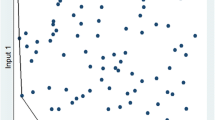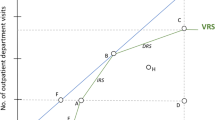Abstract
Applying data envelopment analysis (DEA) to real-world public policy issues can raise many interesting complications beyond those considered in standard models of DEA. One of these complications arises if the funding levels of public service providers, and their ability to attract and retain clients and able staff, depend upon the quality of the output which they produce. This dependency introduces additional inter-relationships between inputs and outputs beyond the uni-directional production possibility frontier (PPF) relationship considered by standard DEA models. The paper therefore analyses the multiplier effects which can be generated by these additional relationships, in which key resource inputs become endogenous variables subject to the external environmental variables which the public service provider faces across these different relationships. The magnitude of these multiplier effects can be captured by focussing DEA on the estimation of an Achievement Possibility Frontier, which reveals the wider set of opportunities which are available to a public service provider to improve its own output quality than that revealed by the estimation of the PPF associated with standard models of DEA. In doing so, the paper enables DEA to be still applied, but in modified form, to the estimation of the scope for improved output of any given public service provider in the presence of such resource endogeneity.



Similar content being viewed by others
References
Banker, R. (1996). Hypothesis testing using data envelopment analysis. Journal of productivity Analysis, 7, 139–159.
Banker, R., & Kaplan, R. (2014). William W. Cooper: Innovator, fighter, scholar, and educator. Accounting Horizons, 28(1), 193–203.
Banker, R., & Morey, R. (1986). Efficiency analysis for exogenously fixed inputs and outputs. Operations Research, 34(2), 513–521.
Banker, R., & Natarajan, R. (2011). Statistical tests based on DEA efficiency scores. In W. W. Cooper, L. M. Seiford, & J. Zhu (Eds.), Handbook on data envelopment analysis (2nd ed., pp. 271–295). New York: Springer.
Bifulco, R., & Bretschneider, S. (2001). Estimating school efficiency: A comparison of methods using simulated data. Economics of Education Review, 20(5), 417–429.
Bifulco, R., & Bretschneider, S. (2003). Response to comment on estimating school efficiency. Economics of Education Review, 22(6), 635–638.
Cameron, A. C., & Trivedi, P. K. (2005). Microeconometrics. Cambridge: Cambridge University Press.
Charnes, A., Cooper, W. W., & Rhodes, E. (1978). Measuring the efficiency of decision making units. European Journal of Operational Research, 2, 429–444.
Cook, W. D., Liang, L., & Zhu, J. (2010). Measuring performance of two-stage network structures by DEA: A review and future perspective. Omega-The International Journal of Management Science, 38(6), 423–430.
Cook, W. D., & Zhu, J. (2014). Data envelopment analysis: A handbook on the modeling of internal structures and networks. New York: Springer.
Cooper, W. W., Seiford, L. M., & Tone, K. (2007). Data envelopment analysis (2nd ed.). New York: Springer.
Cordera, J. M., Santin, D., & Sicilia, G. (2013). Dealing with the endogeneity problem in data envelopment analysis. Munich Personal RePEc Archive, paper no. 47475.
Department of Business, Innovation and Skills (DBIS). (2011). Higher education; Students at the heart of the system. Cm 8122. London: HMSO.
Emrouznejad, A., Parker, B., & Tavares, G. (2008). Evaluation of research in efficiency and productivity: A survey and analysis of the first 30 years of scholarly literature in DEA. Socio-Economic Planning Sciences, 42(3), 151–157.
Ericsson, N., & Irons, J. (1994). Testing exogeneity. Oxford: Oxford University Press.
Gujarati, D., & Porter, D. (2009). Basic econometrics (5th ed.). New York: McGraw-Hill.
Higher Education Funding Council for England (HEFCE). (2006). Funding of over £6.7 billion provides a solid platform for future development of higher education. http://webarchive.nationalarchives.gov.uk/20100202100434/http://hefce.ac.uk/news/hefce/2006/grant06_07/
Higher Education Funding Council for England (HEFCE). (2010a). Guide to funding: How HEFCE allocates its funding. Bristol: HEFCE
Higher Education Funding Council for England (HEFCE). (2010b). National student survey: Findings and trends 2006–2009. Bristol: HEFCE.
Higher Education Statistics Agency (HESA). (2015). Total income and expenditure by source of income and category of expenditure 2006/07 and 2007/08. https://www.hesa.ac.uk/dox/dataTables/finance/download/fin0607-0708.xls?v=1.0
Hollingsworth, B. (2008). The measurement of efficiency and productivity in health care delivery. Health Economics, 17(10), 1107–1128.
Izadi, H., Johnes, G., Oskrochi, R., & Crouchley, R. (2002). Stochastic frontier estimation of a CES cost function: The case of higher education in Britain. Economics of Education Review, 21(1), 63–71.
Jesson, D., Mayston, D. J., & Smith, P. (1987). Performance assessment in the education sector: Educational and economic perspectives. Oxford Review of Education, 13(3), 249–266.
Johnes, J., & Johnes, G. (1995). Research funding and performance in UK university departments of economics: A frontier analysis. Economics of Education Review, 14(3), 301–314.
Johnson, A., & Ruggiero, J. (2011). Allocative efficiency measurement with endogenous prices. Economics Letters, 111(1), 81–83.
Kneip, A., Simar, L., & Wilson, P. W. (2015). Hypothesis testing in nonparametric models of production. Journal of Business and Economic Statistics. doi:10.1080/07350015.2015.1049747
Mayston, D. J. (1996). Educational attainment and resource use: Mystery or econometric misspecification? Education Economics, 4(2), 127–142.
Mayston, D. J. (2003). Measuring and managing educational performance. Journal of the Operational Research Society, 54(7), 679–691.
Mayston, D. J. (2007). Competition and resource effectiveness in education. Manchester School, 75(1), 47–64.
Mayston, D. J. (2009). The determinants of cumulative endogeneity bias in multivariate analysis. Journal of Multivariate Analysis, 100(6), 1120–1136.
Mayston, D. J. (2015). Analysing the effectiveness of public service producers with endogenous resourcing. Journal of Productivity Analysis, 44(1), 115–126.
Morishima, M. (1963). Equilibrium, stability and growth. Oxford: Oxford University Press.
Orme, C., & Smith, P. (1996). The potential for endogeneity bias in data envelopment analysis. Journal of the Operational Research Society, 47(1), 73–83.
Quirk, J., & Saponsnik, R. (1968). Introduction to general equilibrium theory and welfare economics. New York: McGraw-Hill.
Ruggiero, J. (1996). On the measurement of technical efficiency in the public sector. European Journal of Operational Research, 90(3), 553–565.
Ruggiero, J. (2003a). Comment on estimating school efficiency. Economics of Education Review, 22(6), 631–634.
Ruggiero, J. (2003b). Rejoinder. Economics of Education Review, 22(6), 639–640.
Smith, P., & Mayston, D. J. (1987). Measuring efficiency in the public sector. Omega-The International Journal of Management Science, 15(3), 181–189.
Acknowledgments
The author is grateful to the Higher Education Statistics Agency (HESA) for supplying relevant data for the empirical analysis, and to the anonymous referees for their very helpful comments on an earlier version of this paper.
Author information
Authors and Affiliations
Corresponding author
Rights and permissions
About this article
Cite this article
Mayston, D.J. Data envelopment analysis, endogeneity and the quality frontier for public services. Ann Oper Res 250, 185–203 (2017). https://doi.org/10.1007/s10479-015-2074-3
Published:
Issue Date:
DOI: https://doi.org/10.1007/s10479-015-2074-3




